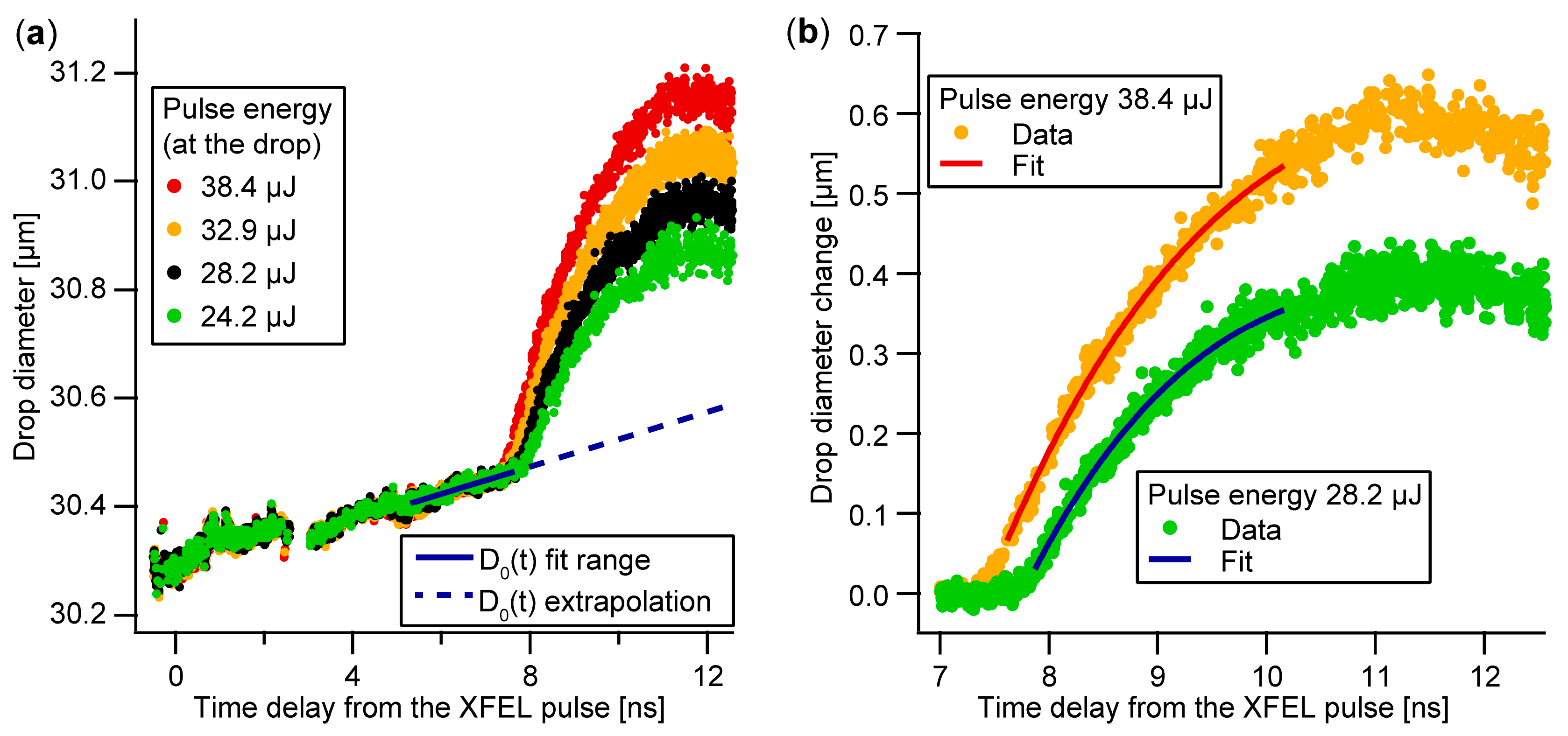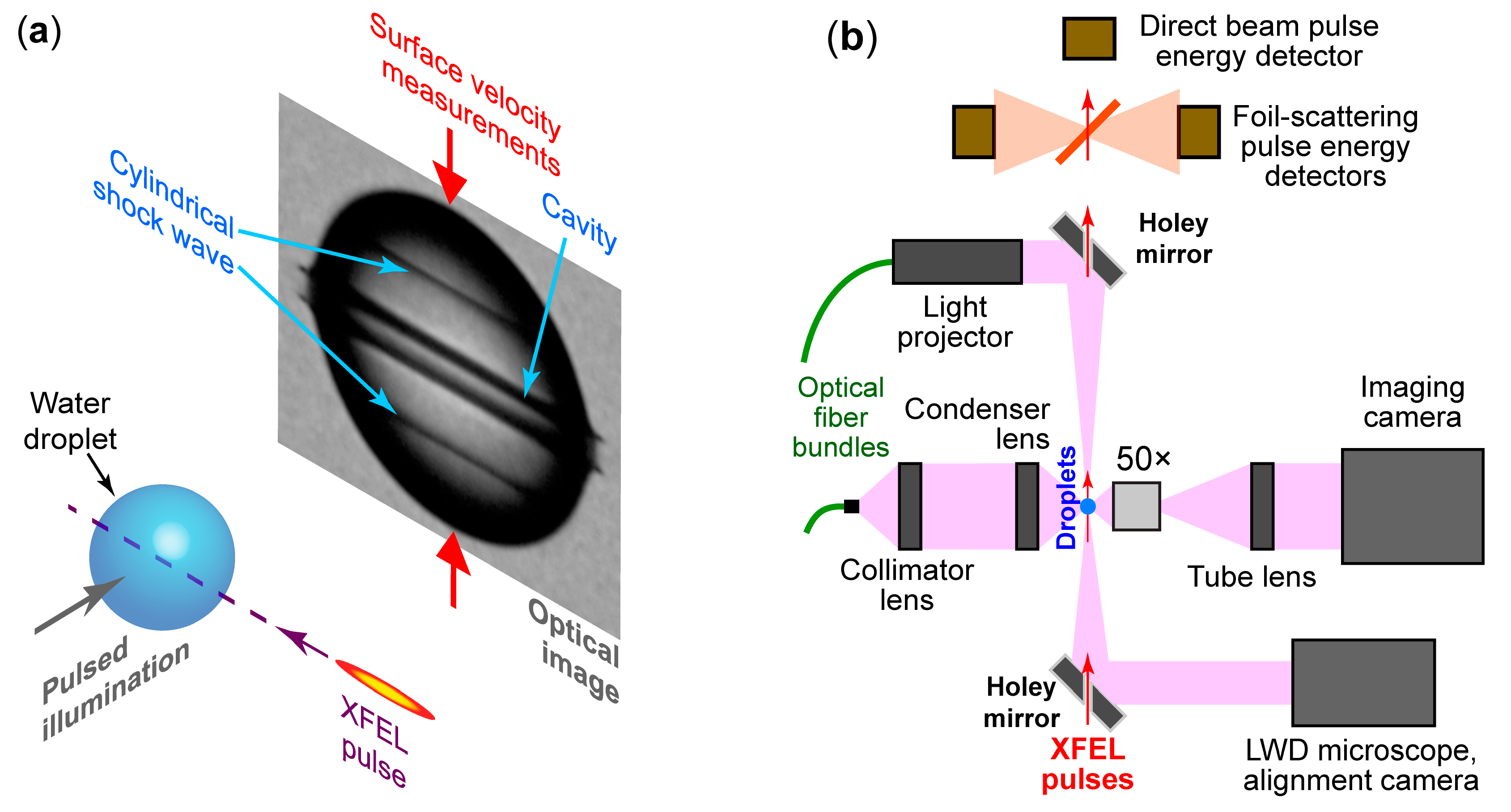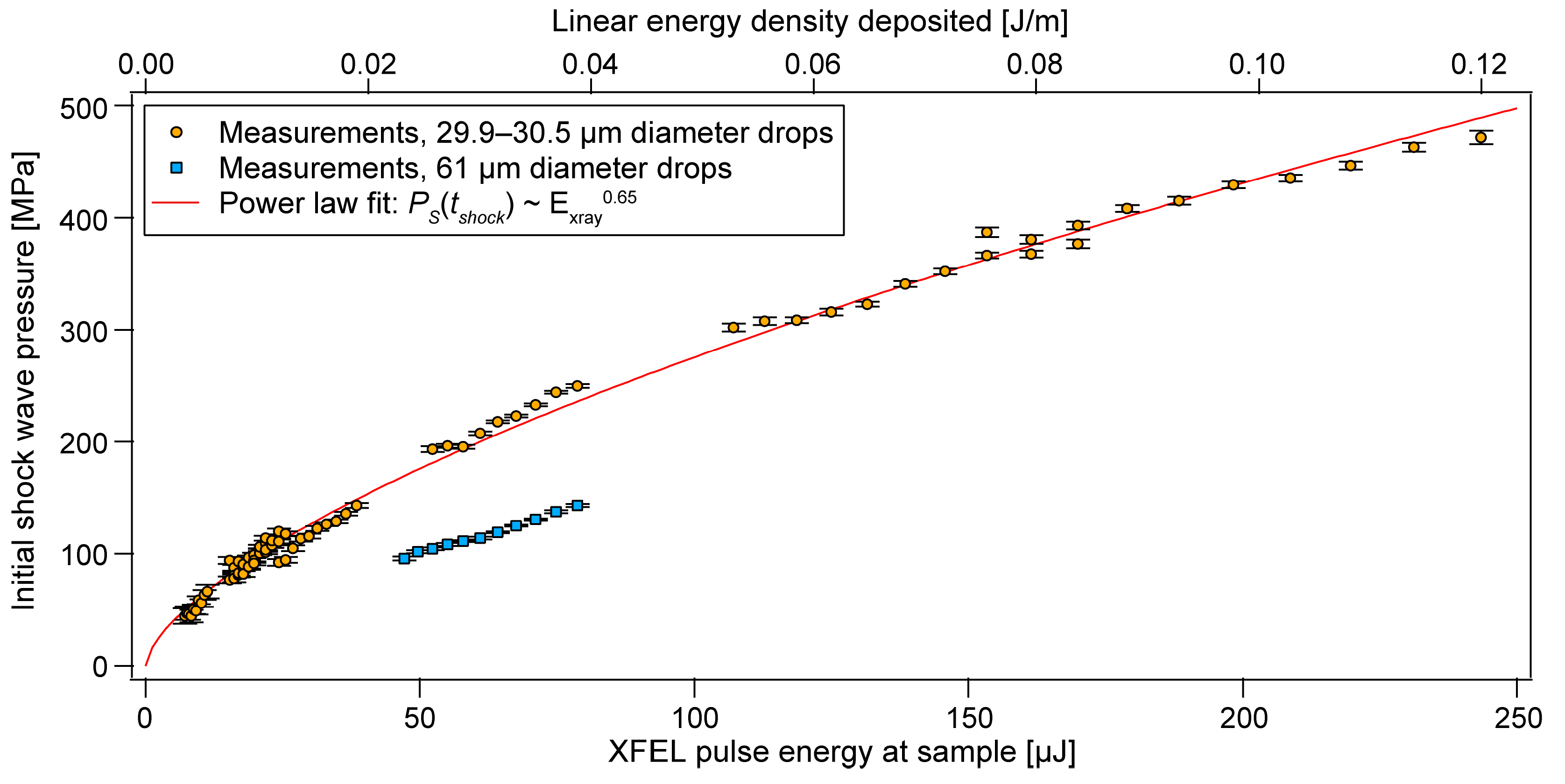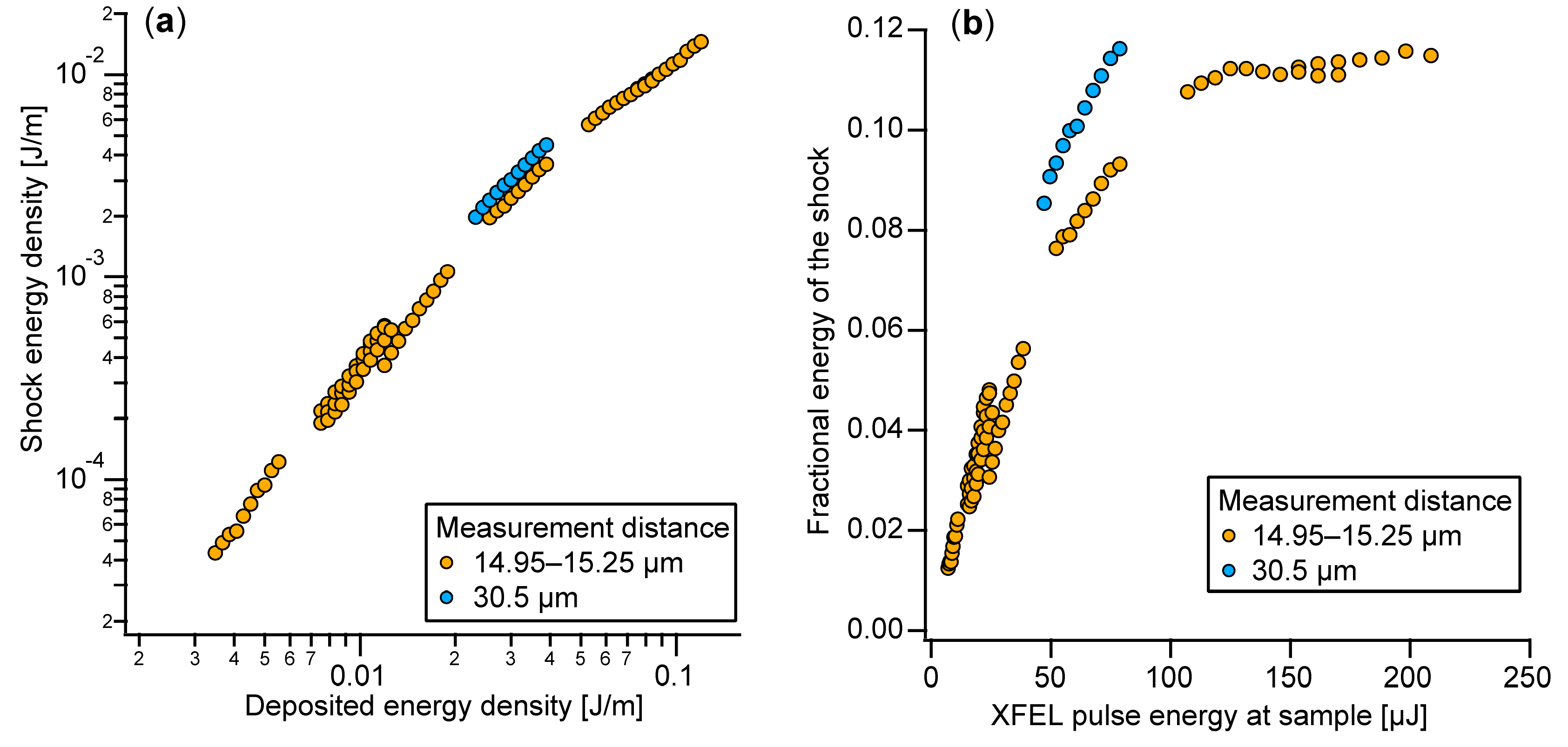The Magnitude and Waveform of Shock Waves Induced by X-ray Lasers in Water
Abstract
1. Introduction
2. Materials and Methods
3. Results
4. Discussion
Author Contributions
Funding
Acknowledgments
Conflicts of Interest
Appendix A

Appendix B
Appendix C
| Ddrop [µm] | Exray [µJ] | V0 [m/s] | σv0 [m/s] | tshock [ns] | σts [ns] | tdecay [ns] | σtd [ns] | PS(tshock) [MPa] |
|---|---|---|---|---|---|---|---|---|
| 30.2 | 7.1 | 113 | 16 | 8.991 | 0.044 | 1.82 | 0.43 | 44 |
| 30.2 | 7.4 | 123 | 15 | 8.943 | 0.039 | 1.72 | 0.34 | 48 |
| 30.2 | 7.8 | 119 | 12 | 8.883 | 0.034 | 2.03 | 0.36 | 46 |
| 30.2 | 8.2 | 121 | 15 | 8.839 | 0.047 | 2.11 | 0.43 | 47 |
| 30.2 | 8.7 | 131 | 12 | 8.819 | 0.033 | 2.05 | 0.31 | 51 |
| 30.2 | 9.1 | 127 | 10 | 8.765 | 0.032 | 2.55 | 0.39 | 50 |
| 30.2 | 9.6 | 142 | 11 | 8.732 | 0.033 | 2.27 | 0.29 | 56 |
| 30.2 | 10.1 | 139 | 9 | 8.677 | 0.028 | 2.61 | 0.32 | 54 |
| 30.2 | 10.7 | 142 | 7 | 8.638 | 0.019 | 2.81 | 0.31 | 56 |
| 30.2 | 11.2 | 145 | 11 | 8.592 | 0.030 | 2.97 | 0.50 | 57 |
| 30.2 | 15.3 | 230 | 7 | 8.242 | 0.012 | 2.09 | 0.08 | 92 |
| 30.5 | 15.3 | 193 | 7 | 8.339 | 0.016 | 2.66 | 0.15 | 77 |
| 30.5 | 16.1 | 202 | 6 | 8.289 | 0.015 | 2.75 | 0.14 | 81 |
| 30.2 | 16.1 | 212 | 6 | 8.139 | 0.011 | 2.72 | 0.12 | 85 |
| 30.5 | 16.1 | 201 | 7 | 8.321 | 0.015 | 2.56 | 0.14 | 80 |
| 30.5 | 16.9 | 207 | 5 | 8.225 | 0.011 | 2.88 | 0.12 | 83 |
| 30.5 | 16.9 | 203 | 5 | 8.265 | 0.012 | 2.73 | 0.11 | 81 |
| 30.2 | 16.9 | 206 | 5 | 8.069 | 0.010 | 3.14 | 0.12 | 82 |
| 30.5 | 17.8 | 208 | 6 | 8.203 | 0.014 | 2.86 | 0.13 | 83 |
| 30.2 | 17.8 | 232 | 5 | 8.061 | 0.011 | 2.85 | 0.10 | 93 |
| 30.5 | 17.8 | 218 | 5 | 8.178 | 0.011 | 2.93 | 0.11 | 87 |
| 30.5 | 18.7 | 221 | 4 | 8.102 | 0.010 | 3.17 | 0.11 | 88 |
| 30.2 | 18.7 | 235 | 4 | 7.981 | 0.009 | 3.06 | 0.09 | 95 |
| 30.5 | 18.7 | 222 | 4 | 8.163 | 0.008 | 2.88 | 0.09 | 89 |
| 30.2 | 19.7 | 238 | 4 | 7.910 | 0.008 | 3.34 | 0.09 | 96 |
| 30.5 | 19.7 | 234 | 5 | 8.071 | 0.011 | 3.30 | 0.12 | 94 |
| 30.5 | 19.7 | 229 | 4 | 8.124 | 0.008 | 3.02 | 0.09 | 92 |
| 30.5 | 20.8 | 254 | 4 | 8.026 | 0.007 | 3.18 | 0.08 | 103 |
| 30.5 | 20.8 | 248 | 4 | 8.092 | 0.008 | 2.94 | 0.07 | 100 |
| 30.2 | 20.8 | 237 | 4 | 7.839 | 0.008 | 3.76 | 0.11 | 95 |
| 30.2 | 21.8 | 242 | 4 | 7.755 | 0.009 | 4.07 | 0.14 | 98 |
| 30.5 | 21.8 | 250 | 4 | 7.947 | 0.009 | 3.63 | 0.11 | 101 |
| 30.5 | 21.8 | 255 | 4 | 8.037 | 0.007 | 3.11 | 0.07 | 103 |
| 30.2 | 23.0 | 266 | 5 | 7.749 | 0.010 | 3.92 | 0.13 | 108 |
| 30.5 | 23.0 | 264 | 4 | 7.981 | 0.007 | 3.27 | 0.08 | 107 |
| 30.5 | 23.0 | 264 | 5 | 7.907 | 0.010 | 3.68 | 0.13 | 107 |
| 30.2 | 24.2 | 273 | 7 | 7.690 | 0.013 | 4.18 | 0.20 | 111 |
| 30.5 | 24.2 | 292 | 6 | 7.870 | 0.012 | 3.44 | 0.12 | 120 |
| 30.5 | 24.2 | 240 | 8 | 7.919 | 0.018 | 3.43 | 0.20 | 97 |
| 30.5 | 24.2 | 272 | 4 | 7.929 | 0.008 | 3.43 | 0.09 | 111 |
| 30.5 | 25.5 | 234 | 5 | 7.841 | 0.011 | 4.16 | 0.19 | 94 |
| 30.5 | 25.5 | 288 | 5 | 7.883 | 0.009 | 3.45 | 0.10 | 118 |
| 30.5 | 26.8 | 260 | 5 | 7.811 | 0.013 | 3.80 | 0.14 | 105 |
| 30.5 | 28.2 | 279 | 5 | 7.762 | 0.009 | 3.78 | 0.11 | 114 |
| 30.5 | 29.7 | 287 | 4 | 7.699 | 0.008 | 3.96 | 0.10 | 117 |
| 30.5 | 31.3 | 298 | 4 | 7.652 | 0.007 | 4.14 | 0.10 | 122 |
| 30.5 | 32.9 | 308 | 3 | 7.591 | 0.006 | 4.33 | 0.08 | 127 |
| 30.5 | 34.7 | 313 | 4 | 7.527 | 0.007 | 4.67 | 0.11 | 129 |
| 30.5 | 36.5 | 331 | 4 | 7.486 | 0.008 | 4.71 | 0.12 | 137 |
| 30.5 | 38.4 | 344 | 5 | 7.420 | 0.011 | 4.81 | 0.14 | 143 |
| 30.0 | 52.2 | 451 | 5 | 6.936 | 0.008 | 5.20 | 0.12 | 194 |
| 30.0 | 55.0 | 457 | 4 | 6.870 | 0.006 | 5.56 | 0.09 | 196 |
| 30.0 | 57.9 | 471 | 4 | 6.812 | 0.006 | 5.63 | 0.09 | 203 |
| 30.0 | 60.9 | 486 | 3 | 6.751 | 0.005 | 5.67 | 0.08 | 211 |
| 30.0 | 64.1 | 500 | 3 | 6.686 | 0.004 | 5.74 | 0.06 | 218 |
| 30.0 | 67.5 | 514 | 3 | 6.630 | 0.004 | 5.92 | 0.06 | 225 |
| 30.0 | 71.1 | 531 | 3 | 6.581 | 0.004 | 6.01 | 0.06 | 233 |
| 30.0 | 74.8 | 554 | 3 | 6.539 | 0.004 | 5.95 | 0.06 | 245 |
| 30.0 | 78.7 | 566 | 3 | 6.487 | 0.004 | 6.11 | 0.07 | 251 |
| 30.1 | 107.1 | 663 | 7 | 6.203 | 0.080 | 7.03 | 0.16 | 302 |
| 30.1 | 112.8 | 673 | 6 | 6.142 | 0.007 | 7.36 | 0.15 | 308 |
| 30.1 | 118.7 | 674 | 5 | 6.080 | 0.006 | 7.93 | 0.15 | 308 |
| 30.1 | 124.9 | 688 | 5 | 6.032 | 0.006 | 8.18 | 0.16 | 316 |
| 30.1 | 131.5 | 700 | 4 | 5.981 | 0.004 | 8.33 | 0.14 | 323 |
| 30.1 | 138.4 | 733 | 5 | 5.942 | 0.004 | 7.78 | 0.13 | 341 |
| 30.1 | 145.7 | 754 | 5 | 5.898 | 0.004 | 7.67 | 0.12 | 352 |
| 28.9 | 153.4 | 815 | 8 | 5.823 | 0.006 | 7.19 | 0.17 | 387 |
| 30.1 | 153.4 | 778 | 4 | 5.859 | 0.004 | 7.54 | 0.11 | 366 |
| 30.1 | 161.5 | 781 | 5 | 5.796 | 0.005 | 7.90 | 0.13 | 368 |
| 28.9 | 161.5 | 804 | 7 | 5.757 | 0.006 | 8.09 | 0.17 | 381 |
| 30.1 | 170.0 | 797 | 6 | 5.753 | 0.006 | 8.02 | 0.17 | 377 |
| 28.9 | 170.0 | 825 | 6 | 5.712 | 0.005 | 8.06 | 0.17 | 393 |
| 28.9 | 178.9 | 851 | 5 | 5.669 | 0.004 | 7.94 | 0.14 | 408 |
| 28.9 | 188.3 | 864 | 6 | 5.613 | 0.004 | 8.21 | 0.16 | 415 |
| 28.9 | 198.2 | 887 | 5 | 5.577 | 0.004 | 8.26 | 0.14 | 429 |
| 28.9 | 208.7 | 897 | 5 | 5.520 | 0.004 | 8.48 | 0.16 | 435 |
| 29.9 | 219.7 | 916 | 6 | 5.473 | 0.004 | 8.59 | 0.18 | 447 |
| 29.9 | 231.2 | 943 | 7 | 5.429 | 0.004 | 8.58 | 0.20 | 463 |
| 29.9 | 243.4 | 957 | 10 | 5.377 | 0.006 | 8.75 | 0.30 | 472 |
| 61.0 | 47.1 | 238 | 4 | 16.507 | 0.031 | 10.58 | 0.27 | 96 |
| 61.0 | 49.6 | 252 | 3 | 16.464 | 0.025 | 10.43 | 0.21 | 102 |
| 61.0 | 52.2 | 257 | 3 | 16.369 | 0.022 | 10.92 | 0.20 | 104 |
| 61.0 | 55.0 | 266 | 3 | 16.295 | 0.021 | 11.09 | 0.18 | 108 |
| 61.0 | 57.9 | 274 | 2 | 16.172 | 0.017 | 11.40 | 0.16 | 111 |
| 61.0 | 60.9 | 279 | 2 | 16.064 | 0.018 | 11.68 | 0.17 | 114 |
| 61.0 | 64.1 | 291 | 2 | 15.997 | 0.017 | 11.57 | 0.15 | 119 |
| 61.0 | 67.5 | 305 | 2 | 15.929 | 0.014 | 11.33 | 0.12 | 125 |
| 61.0 | 71.1 | 317 | 2 | 15.860 | 0.014 | 11.18 | 0.12 | 131 |
| 61.0 | 74.8 | 332 | 2 | 15.801 | 0.014 | 10.91 | 0.12 | 138 |
| 61.0 | 78.7 | 344 | 3 | 15.712 | 0.016 | 10.76 | 0.14 | 143 |
References
- Vogel, A.; Venugopalan, V. Mechanisms of Pulsed Laser Ablation of Biological Tissues. Chem. Rev. 2003, 103, 577–644. [Google Scholar] [CrossRef]
- Vogel, A.; Noack, J.; Huttman, G.; Paltauf, G. Mechanisms of femtosecond laser nanosurgery of cells and tissues. Appl. Phys. B 2005, 81, 1015–1047. [Google Scholar] [CrossRef]
- Chichkov, B.N.; Momma, C.; Nolte, S.; von Alvensleben, F.; Tunnermann, A. Femtosecond, picosecond and nanosecond laser ablation of solids. Appl. Phys. A 1996, 63, 109–115. [Google Scholar] [CrossRef]
- Nolte, S.; Momma, C.; Jacobs, H.; Tunnermann, A.; Chichkov, B.N.; Wellegehausen, B.; Welling, H. Ablation of metals by ultrashort laser pulses. J. Opt. Soc. Am. B Opt. Phys. 1997, 14, 2716–2722. [Google Scholar] [CrossRef]
- Liu, X.; Du, D.; Mourou, G. Laser ablation and micromachining with ultrashort laser pulses. IEEE J. Quantum Electron. 1997, 33, 1706–1716. [Google Scholar] [CrossRef]
- Yang, G.W. Laser ablation in liquids: Applications in the synthesis of nanocrystals. Prog. Mater. Sci. 2007, 52, 648–698. [Google Scholar] [CrossRef]
- Vogel, A.; Lauterborn, W. Acoustic Transient Generation by Laser-Produced Cavitation Bubbles near Solid Boundaries. J. Acoust. Soc. Am. 1988, 84, 719–731. [Google Scholar] [CrossRef]
- Vogel, A.; Noack, J. Shock-wave energy and acoustic energy dissipation after laser-induced breakdown. In Laser-Tissue Interaction IX; International Society for Optics and Photonics: Bellingham, WA, USA, 1998; pp. 180–189. [Google Scholar]
- Anderhol, N.C. Laser-generated stress waves. Appl. Phys. Lett. 1970, 16, 113–115. [Google Scholar] [CrossRef]
- Smith, R.F.; Eggert, J.H.; Jeanloz, R.; Duffy, T.S.; Braun, D.G.; Patterson, J.R.; Rudd, R.E.; Biener, J.; Lazicki, A.E.; Hamza, A.V.; et al. Ramp compression of diamond to five terapascals. Nature 2014, 511, 330–333. [Google Scholar] [CrossRef]
- Meyers, M.A.; Gregori, F.; Kad, B.K.; Schneider, M.S.; Kalantar, D.H.; Remington, B.A.; Ravichandran, G.; Boehly, T.; Wark, J.S. Laser-induced shock compression of monocrystalline copper: Characterization and analysis. Acta Mater. 2003, 51, 1211–1228. [Google Scholar] [CrossRef]
- Carlson, G.A. Dynamic tensile strength of mercury. J. Appl. Phys. 1975, 46, 4069–4070. [Google Scholar] [CrossRef]
- Fortov, V.E.; Kostin, V.V.; Eliezer, S. Spallation of metals under laser irradiation. J. Appl. Phys. 1991, 70, 4524–4531. [Google Scholar] [CrossRef]
- Tamura, H.; Kohama, T.; Kondo, K.; Yoshida, M. Femtosecond-laser-induced spallation in aluminum. J. Appl. Phys. 2001, 89, 3520–3522. [Google Scholar] [CrossRef]
- Paltauf, G.; Schmidt-Kloiber, H. Microcavity dynamics during laser-induced spallation of liquids and gels. Appl. Phys. A 1996, 62, 303–311. [Google Scholar] [CrossRef]
- Ando, K.; Liu, A.Q.; Ohl, C.D. Homogeneous Nucleation in Water in Microfluidic Channels. Phys. Rev. Lett. 2012, 109, 044501. [Google Scholar] [CrossRef]
- Stan, C.A.; Willmott, P.R.; Stone, H.A.; Koglin, J.E.; Liang, M.; Aquila, A.L.; Robinson, J.S.; Gumerlock, K.L.; Blaj, G.; Sierra, R.G.; et al. Negative Pressures and Spallation in Water Drops Subjected to Nanosecond Shock Waves. J. Phys. Chem. Lett. 2016, 7, 2055–2062. [Google Scholar] [CrossRef]
- Emma, P.; Akre, R.; Arthur, J.; Bionta, R.; Bostedt, C.; Bozek, J.; Brachmann, A.; Bucksbaum, P.; Coffee, R.; Decker, F.J.; et al. First lasing and operation of an ångstrom-wavelength free-electron laser. Nat. Photon. 2010, 4, 641–647. [Google Scholar] [CrossRef]
- Ishikawa, T.; Aoyagi, H.; Asaka, T.; Asano, Y.; Azumi, N.; Bizen, T.; Ego, H.; Fukami, K.; Fukui, T.; Furukawa, Y.; et al. A compact X-ray free-electron laser emitting in the sub-ångström region. Nat. Photon. 2012, 6, 540–544. [Google Scholar] [CrossRef]
- Mimura, H.; Yumoto, H.; Matsuyama, S.; Koyama, T.; Tono, K.; Inubushi, Y.; Togashi, T.; Sato, T.; Kim, J.; Fukui, R.; et al. Generation of 10^20 Wcm^-2 hard X-ray laser pulses with two-stage reflective focusing system. Nat. Commun. 2014, 5, 3539. [Google Scholar] [CrossRef]
- Vinko, S.M.; Ciricosta, O.; Cho, B.I.; Engelhorn, K.; Chung, H.K.; Brown, C.R.D.; Burian, T.; Chalupsky, J.; Falcone, R.W.; Graves, C.; et al. Creation and diagnosis of a solid-density plasma with an X-ray free-electron laser. Nature 2012, 482, 59–62. [Google Scholar] [CrossRef]
- Yoneda, H.; Inubushi, Y.; Yabashi, M.; Katayama, T.; Ishikawa, T.; Ohashi, H.; Yumoto, H.; Yamauchi, K.; Mimura, H.; Kitamura, H. Saturable absorption of intense hard X-rays in iron. Nat. Commun. 2014, 5, 5080. [Google Scholar] [CrossRef] [PubMed]
- Beyerlein, K.R.; Jonsson, H.O.; Alonso-Mori, R.; Aquila, A.; Barty, S.; Barty, A.; Bean, R.; Koglin, J.E.; Messerschmidt, M.; Ragazzon, D.; et al. Ultrafast nonthermal heating of water initiated by an X-ray Free-Electron Laser. Proc. Natl. Acad. Sci. USA 2018, 115, 5652–5657. [Google Scholar] [CrossRef] [PubMed]
- Stan, C.A.; Milathianaki, D.; Laksmono, H.; Sierra, R.G.; McQueen, T.A.; Messerschmidt, M.; Williams, G.J.; Koglin, J.E.; Lane, T.J.; Hayes, M.J.; et al. Liquid explosions induced by X-ray laser pulses. Nat. Phys. 2016, 12, 966–971. [Google Scholar] [CrossRef]
- Chapman, H.N.; Fromme, P.; Barty, A.; White, T.A.; Kirian, R.A.; Aquila, A.; Hunter, M.S.; Schulz, J.; DePonte, D.P.; Weierstall, U.; et al. Femtosecond X-ray protein nanocrystallography. Nature 2011, 470, 73–77. [Google Scholar] [CrossRef]
- Altarelli, M. The European X-ray Free-Electron Laser: Toward an ultra-bright, high repetition-rate x-ray source. High Power Laser Sci. 2015, 3, e18. [Google Scholar] [CrossRef]
- Grünbein, M.L.; Bielecki, J.; Gorel, A.; Stricker, M.; Bean, R.; Cammarata, M.; Doerner, K.; Fröhlich, L.; Hartmann, L.; Hauf, S.; et al. Megahertz Data Collection from Protein Microcrystals at an X-ray Free-Electron Laser. Nat. Commun. 2018, 9, 3847. [Google Scholar] [CrossRef]
- Wiedorn, M.O.; Oberthür, D.; Bean, R.; Schubert, R.; Werner, N.; Abbey, B.; Aepfelbacher, M.; Adriano, A.; Allahgholi, A.; Al-Qudami, N.; et al. Megahertz serial crystallography. Nat. Commun. 2018, 9, 4025. [Google Scholar] [CrossRef]
- Yefanov, O.; Oberthür, D.; Bean, R.; Wiedorn, M.O.; Knoska, J.; Pena, G.; Awel, S.; Gumprecht, L.; Domaracky, M.; Sarrou, I.; et al. Evaluation of serial crystallographic structure determination within megahertz pulse trains. Struct. Dyn. 2019, 6, 064702. [Google Scholar] [CrossRef]
- Blaj, G.; Liang, M.N.; Aquila, A.L.; Willmott, P.R.; Koglin, J.E.; Sierra, R.G.; Robinson, J.S.; Boutet, S.; Stan, C.A. Generation of high-intensity ultrasound through shock propagation in liquid jets. Phys. Rev. Fluids 2019, 4, 043401. [Google Scholar] [CrossRef]
- Tono, K.; Togashi, T.; Inubushi, Y.; Sato, T.; Katayama, T.; Ogawa, K.; Ohashi, H.; Kimura, H.; Takahashi, S.; Takeshita, K.; et al. Beamline, experimental stations and photon beam diagnostics for the hard x-ray free electron laser of SACLA. New J. Phys. 2013, 15, 083035. [Google Scholar] [CrossRef]
- Yumoto, H.; Mimura, H.; Koyama, T.; Matsuyama, S.; Tono, K.; Togashi, T.; Inubushi, Y.; Sato, T.; Tanaka, T.; Kimura, T.; et al. Focusing of X-ray free-electron laser pulses with reflective optics. Nat. Photon. 2013, 7, 43–47. [Google Scholar] [CrossRef]
- Walsh, J.M.; Christian, R.H. Equation of State of Metals from Shock Wave Measurements. Phys. Rev. 1955, 97, 1544–1556. [Google Scholar] [CrossRef]
- Henderson, L.F. On the refraction of shock waves. J. Fluid Mech. 1989, 198, 365–386. [Google Scholar] [CrossRef]
- Tono, K.; Kudo, T.; Yabashi, M.; Tachibana, T.; Feng, Y.P.; Fritz, D.; Hastings, J.; Ishikawa, T. Single-shot beam-position monitor for x-ray free electron laser. Rev. Sci. Instrum. 2011, 82, 023108. [Google Scholar] [CrossRef] [PubMed]
- Kudo, T.; Tono, K.; Yabashi, M.; Togashi, T.; Sato, T.; Inubushi, Y.; Omodani, M.; Kirihara, Y.; Matsushita, T.; Kobayashi, K.; et al. A photodiode amplifier system for pulse-by-pulse intensity measurement of an x-ray free electron laser. Rev. Sci. Instrum. 2012, 83, 043108. [Google Scholar] [CrossRef] [PubMed]
- Kato, M.; Tanaka, T.; Kurosawa, T.; Saito, N.; Richter, M.; Sorokin, A.A.; Tiedtke, K.; Kudo, T.; Tono, K.; Yabashi, M.; et al. Pulse energy measurement at the hard x-ray laser in Japan. Appl. Phys. Lett. 2012, 101, 023503. [Google Scholar] [CrossRef]
- Grady, D. Shocks and structured waves. In Physics of Shock and Impact; IOP Publishing Ltd.: Bristol, UK, 2017. [Google Scholar]
- Nagayama, K.; Mori, Y.; Shimada, K.; Nakahara, M. Shock Hugoniot compression curve for water up to 1 GPa by using a compressed gas gun. J. Appl. Phys. 2002, 91, 476–482. [Google Scholar] [CrossRef]
- Fowles, R.; Williams, R.F. Plane Stress Wave Propagation in Solids. J. Appl. Phys. 1970, 41, 360–363. [Google Scholar] [CrossRef]
- Aidun, J.B.; Gupta, Y.M. Analysis of Lagrangian Gauge Measurements of Simple and Nonsimple Plane-Waves. J. Appl. Phys. 1991, 69, 6998–7014. [Google Scholar] [CrossRef]
- Grady, D. Shock wave analysis and applications. In Physics of Shock and Impact; IOP Publishing Ltd.: Bristol, UK, 2017. [Google Scholar]
- Fowles, R. Conservation Relations for Spherical and Cylindrical Stress Waves. J. Appl. Phys. 1970, 41, 2740–2741. [Google Scholar] [CrossRef]
- Rice, M.H.; Walsh, J.M. Equation of State of Water to 250 Kilobars. J. Chem. Phys. 1957, 26, 824–830. [Google Scholar] [CrossRef]
- Lyu, X.X.; Pan, S.C.; Hu, X.Y.; Adams, N.A. Numerical investigation of homogeneous cavitation nucleation in a microchannel. Phys. Rev. Fluids 2018, 3, 064303. [Google Scholar] [CrossRef]
- Veysset, D.; Gutierrez-Hernandez, U.; Dresselhaus-Cooper, L.; De Colle, F.; Kooi, S.; Nelson, K.A.; Quinto-Su, P.A.; Pezeril, T. Single-bubble and multibubble cavitation in water triggered by laser-driven focusing shock waves. Phys. Rev. E 2018, 97, 053112. [Google Scholar] [CrossRef] [PubMed]
- Paula, T.; Adami, S.; Adams, N.A. Analysis of the early stages of liquid-water-drop explosion by numerical simulation. Phys. Rev. Fluids 2019, 4, 044003. [Google Scholar] [CrossRef]
- Cai, Y.; Wu, H.A.; Luo, S.N. Spall strength of liquid copper and accuracy of the acoustic method. J. Appl. Phys. 2017, 121, 105901. [Google Scholar] [CrossRef]
- Barker, L.; Hollenbach, R. Laser interferometer for measuring high velocities of any reflecting surface. J. Appl. Phys. 1972, 43, 4669–4675. [Google Scholar] [CrossRef]
- Menezes, V.; Hosseini, H.; Moosavi-Nejad, S.; Irimpan, K.J.; Akiyama, H. Motion of free-surface of shock-compressed water on emergence of rarefaction. Appl. Phys. Lett. 2015, 107, 143701. [Google Scholar] [CrossRef]
- Li, Z.G.; Xiong, S.; Chin, L.K.; Ando, K.; Zhang, J.B.; Liu, A.Q. Water’s tensile strength measured using an optofluidic chip. Lab Chip 2015, 15, 2158–2161. [Google Scholar] [CrossRef]
- Savitzky, A.; Golay, M.J.E. Smoothing and Differentiation of Data by Simplified Least Squares Procedures. Anal. Chem. 1964, 36, 1627–1639. [Google Scholar] [CrossRef]
- Friedlander, F.G. The Diffraction of Sound Pulses 1. Diffraction by a Semi-Infinite Plane. Proc. R. Soc. Lond. Ser. A 1946, 186, 322–344. [Google Scholar]
- Dewey, J.M. The Friedlander Equations. In Blast Effects: Physical Properties of Shock Waves, 1st ed.; Sochet, I., Ed.; Springer: Cham, Switzerland, 2018; pp. 37–55. [Google Scholar]
- Krehl, P.O.K. The classical Rankine-Hugoniot jump conditions, an important cornerstone of modern shock wave physics: Ideal assumptions vs. reality. Eur. Phys. J. H 2015, 40, 159–204. [Google Scholar] [CrossRef]
- Luo, S.N.; Han, L.B.; Xie, Y.; An, Q.; Zheng, L.Q.; Xia, K.W. The relation between shock-state particle velocity and free surface velocity: A molecular dynamics study on single crystal Cu and silica glass. J. Appl. Phys. 2008, 103, 093530. [Google Scholar] [CrossRef]
- Rothman, S.D.; Davis, J.P.; Maw, J.; Robinson, C.M.; Parker, K.; Palmer, J. Measurement of the principal isentropes of lead and lead-antimony alloy to similar to 400 kbar by quasi-isentropic compression. J. Phys. D Appl. Phys. 2005, 38, 733–740. [Google Scholar] [CrossRef]
- Kinsler, L.E.; Frey, A.R.; Coppens, A.B.; Sanders, J.V. The acoustic wave equation and simple solutions. In Fundamentals of Acoustics, 4th ed.; John Wiley & Sons, Inc.: New York, NY, USA, 1999; pp. 113–148. [Google Scholar]
- Thompson, P.A. Compressible-Fluid Dynamics; McGraw-Hill: New York, NY, USA, 1972; pp. 102–103. [Google Scholar]





© 2020 by the authors. Licensee MDPI, Basel, Switzerland. This article is an open access article distributed under the terms and conditions of the Creative Commons Attribution (CC BY) license (http://creativecommons.org/licenses/by/4.0/).
Share and Cite
Stan, C.A.; Motomura, K.; Blaj, G.; Kumagai, Y.; Li, Y.; You, D.; Ono, T.; Kalita, A.; Togashi, T.; Owada, S.; et al. The Magnitude and Waveform of Shock Waves Induced by X-ray Lasers in Water. Appl. Sci. 2020, 10, 1497. https://doi.org/10.3390/app10041497
Stan CA, Motomura K, Blaj G, Kumagai Y, Li Y, You D, Ono T, Kalita A, Togashi T, Owada S, et al. The Magnitude and Waveform of Shock Waves Induced by X-ray Lasers in Water. Applied Sciences. 2020; 10(4):1497. https://doi.org/10.3390/app10041497
Chicago/Turabian StyleStan, Claudiu Andrei, Koji Motomura, Gabriel Blaj, Yoshiaki Kumagai, Yiwen Li, Daehyun You, Taishi Ono, Armin Kalita, Tadashi Togashi, Shigeki Owada, and et al. 2020. "The Magnitude and Waveform of Shock Waves Induced by X-ray Lasers in Water" Applied Sciences 10, no. 4: 1497. https://doi.org/10.3390/app10041497
APA StyleStan, C. A., Motomura, K., Blaj, G., Kumagai, Y., Li, Y., You, D., Ono, T., Kalita, A., Togashi, T., Owada, S., Tono, K., Yabashi, M., Katayama, T., & Ueda, K. (2020). The Magnitude and Waveform of Shock Waves Induced by X-ray Lasers in Water. Applied Sciences, 10(4), 1497. https://doi.org/10.3390/app10041497







